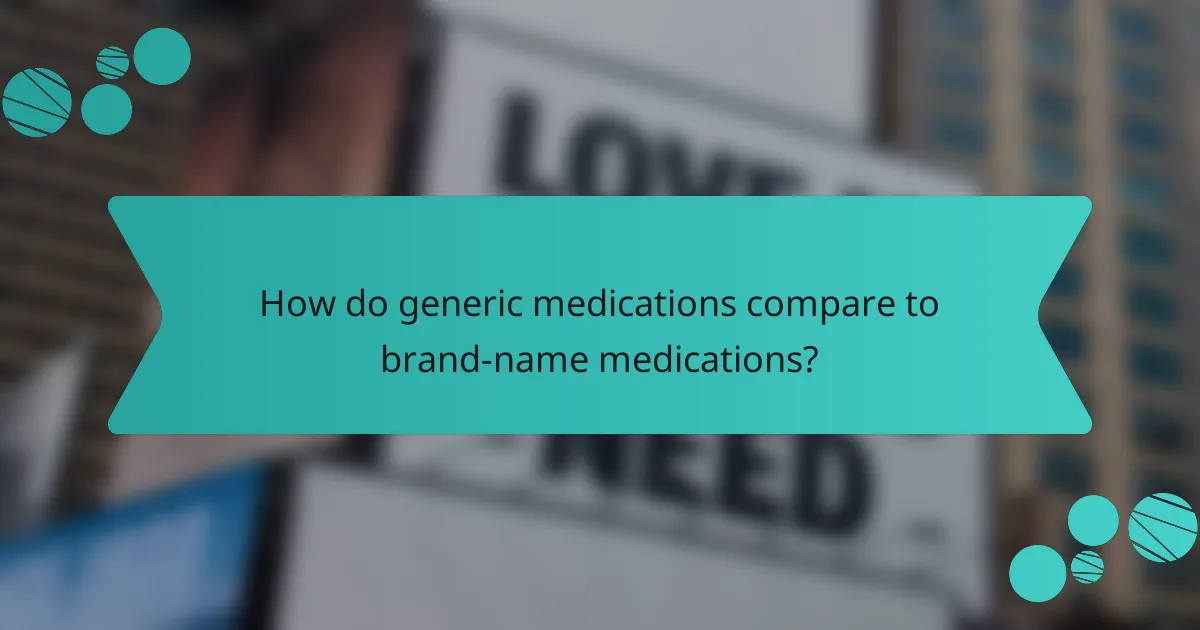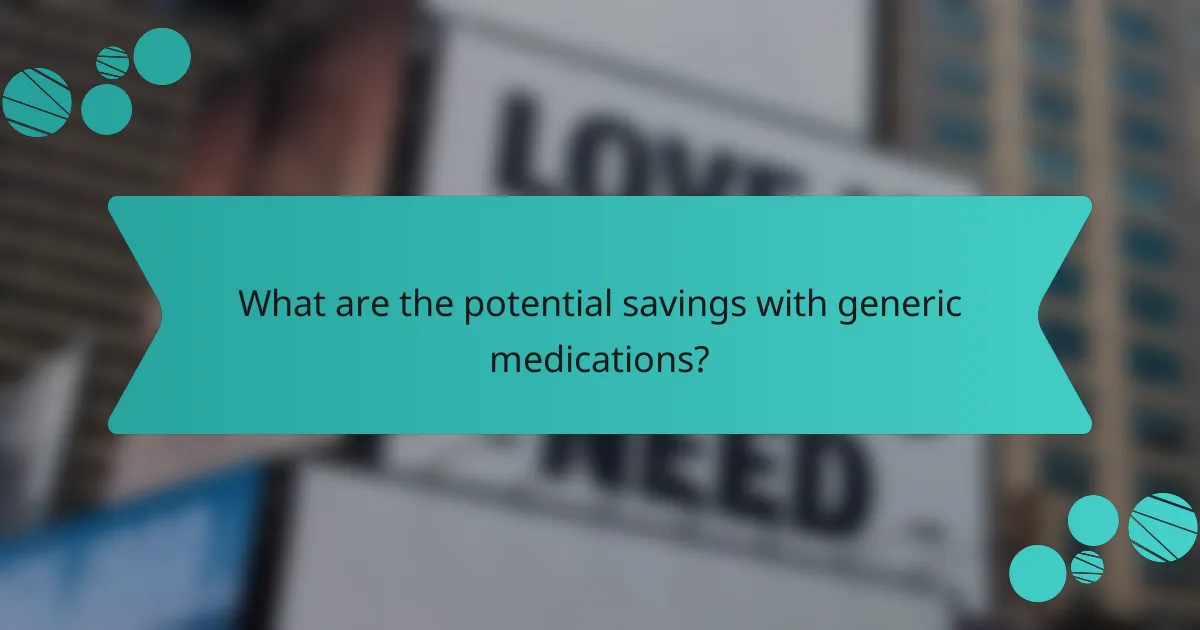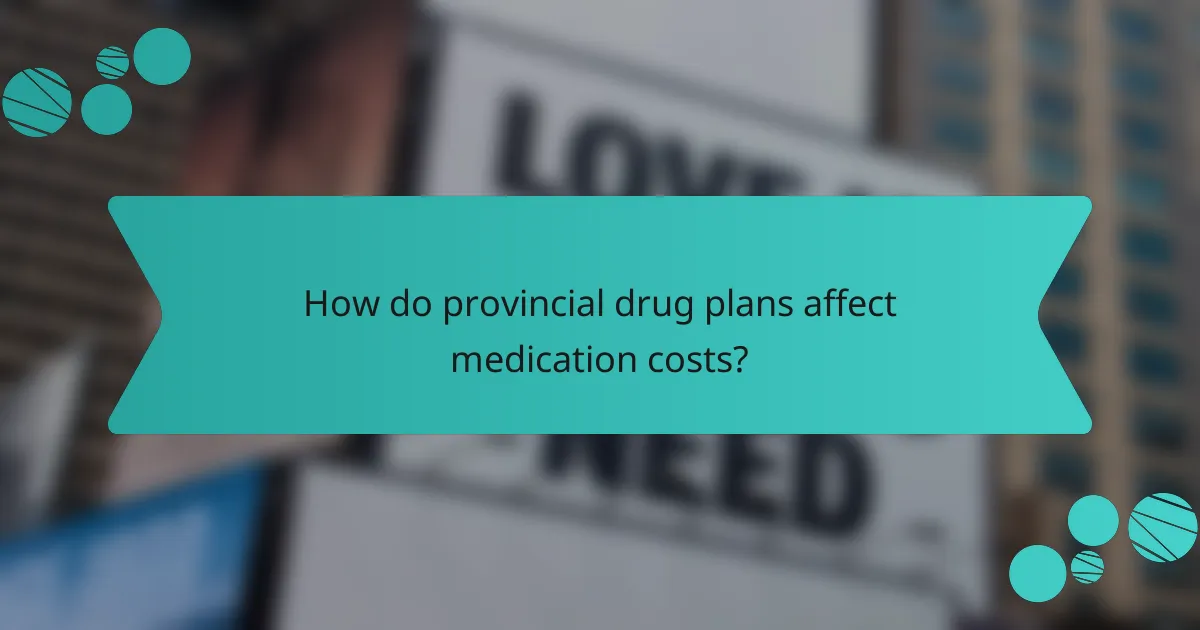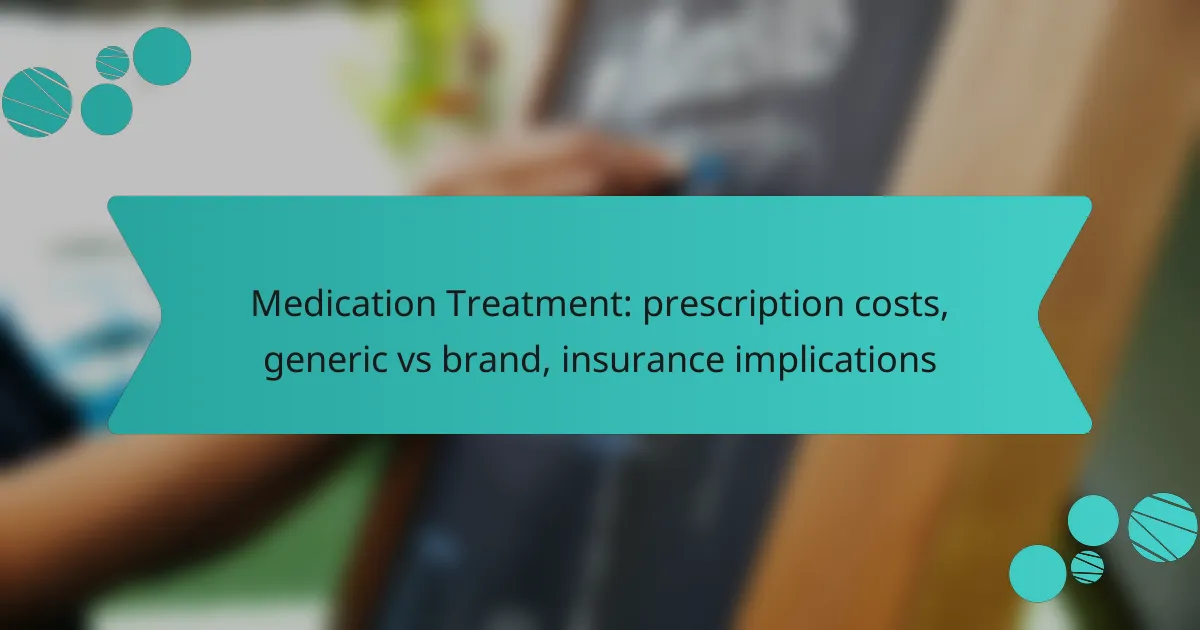Prescription medication costs in Canada can vary significantly based on factors such as the type of medication, whether it is a brand name or generic, and the patient’s insurance coverage. Generic medications often provide a more affordable alternative to brand-name drugs while maintaining the same active ingredients and therapeutic effects. Understanding the implications of insurance coverage is crucial for managing out-of-pocket expenses and ensuring access to necessary treatments.

What are the prescription medication costs in Canada?
Prescription medication costs in Canada can vary widely based on factors such as the type of medication, whether it is a brand name or generic, and the patient’s insurance coverage. Generally, Canadians pay out-of-pocket for medications unless they have private insurance or are covered under provincial health plans.
Average costs for common medications
The average cost of prescription medications in Canada can range from a few dollars to several hundred dollars per month. For example, common medications like statins or antihypertensives may cost between CAD 10 to CAD 50 for a month’s supply, while specialty drugs for conditions like cancer can exceed CAD 1,000 monthly. Generic versions are typically less expensive, often costing 30-80% less than their brand-name counterparts.
Factors affecting prescription prices
Insurance coverage is another critical factor; those with private insurance may pay significantly less due to negotiated rates. It’s advisable for patients to compare prices at different pharmacies and consider using generic options when available to reduce costs.

How do generic medications compare to brand-name medications?
Generic medications are typically less expensive alternatives to brand-name drugs, offering the same active ingredients and therapeutic effects. While they are required to meet the same safety and efficacy standards set by regulatory agencies, there are important differences to consider regarding cost, effectiveness, and safety.
Cost differences between generic and brand-name
Generic medications usually cost significantly less than their brand-name counterparts, often by 30-80%. This price difference is due to lower development costs and the absence of marketing expenses associated with brand-name drugs. For example, a brand-name medication that costs $200 may have a generic version available for $40 to $70.
Insurance plans often favor generics, resulting in lower copays for patients. It’s advisable to check with your insurance provider to understand the specifics of your coverage and any potential savings when opting for generic medications.
Effectiveness and safety of generics
Generic medications are required to have the same active ingredients, dosage forms, and routes of administration as brand-name drugs, ensuring comparable effectiveness and safety. Regulatory bodies like the FDA mandate that generics demonstrate bioequivalence, meaning they work in the same way and provide the same clinical benefit.
While generics are generally safe, some patients may experience differences in inactive ingredients, which can affect tolerability. If you have concerns about switching from a brand-name to a generic medication, consult your healthcare provider for personalized advice.

What are the insurance implications for prescription medications?
Insurance implications for prescription medications can significantly affect out-of-pocket costs and access to necessary treatments. Understanding your coverage options and the nuances of your insurance plan is essential for managing these expenses effectively.
Coverage options for medications in Canada
In Canada, prescription medication coverage varies widely among provinces and insurance plans. Public health insurance typically covers essential drugs, but many Canadians also rely on private insurance to fill gaps. Some provinces have a formulary, which lists covered medications, while others may require prior authorization for certain prescriptions.
For those without insurance, provincial drug programs may offer assistance, particularly for low-income individuals or seniors. It’s crucial to check the specific coverage details and any potential co-pays associated with your plan.
Out-of-pocket costs with different insurance plans
Out-of-pocket costs for prescriptions can differ based on the type of insurance plan you have. Plans may have varying deductibles, co-pays, and coverage limits that influence how much you pay for medications. For example, a plan with a low premium might have higher co-pays, while a higher premium plan could offer lower costs at the pharmacy.
It’s advisable to compare plans during open enrollment periods to find one that best fits your medication needs. Additionally, consider using generic medications when available, as they often have lower co-pays and can reduce overall expenses significantly.

How to choose between generic and brand-name medications?
Choosing between generic and brand-name medications depends on factors such as cost, effectiveness, and personal health needs. Generally, generic medications are less expensive and contain the same active ingredients as their brand-name counterparts, making them a practical choice for many patients.
Criteria for selecting medications
When selecting between generic and brand-name medications, consider the cost, availability, and your specific health conditions. Generic medications often cost significantly less, sometimes by 30-80%, which can lead to substantial savings over time.
Additionally, check if the generic version is available for your prescribed medication. Some brand-name drugs may not have a generic equivalent yet, especially if they are still under patent protection. Always review the formulation and dosage to ensure they match your treatment requirements.
Consultation with healthcare providers
Consulting with your healthcare provider is crucial when deciding between generic and brand-name medications. They can provide insights into the efficacy of both options and help assess any potential side effects based on your medical history.
Discuss any concerns regarding allergies or previous reactions to medications. Your provider may also have recommendations based on the latest research or patient experiences, ensuring you make an informed choice that aligns with your health goals.

What are the potential savings with generic medications?
Generic medications can offer significant savings compared to their brand-name counterparts, often costing 30-80% less. These savings arise from lower development and marketing costs, making generics an attractive option for patients and healthcare systems alike.
Long-term cost benefits
Choosing generic medications can lead to substantial long-term savings for patients. For instance, if a patient requires a medication for a chronic condition, switching from a brand-name drug to a generic can save hundreds to thousands of dollars annually. Over time, these savings can accumulate, allowing patients to allocate funds to other healthcare needs or personal expenses.
Additionally, as more generics enter the market, competition can drive prices down further. Patients should regularly review their prescriptions and consult with their healthcare providers about generic options that may be available.
Impact on overall healthcare expenses
The widespread use of generic medications can significantly reduce overall healthcare expenses for both individuals and insurance providers. When patients opt for generics, insurers often see lower claim costs, which can lead to reduced premiums for policyholders. This shift can help make healthcare more affordable for everyone.
Moreover, when healthcare systems encourage the use of generics, they can redirect funds to other critical areas, such as preventive care and public health initiatives. Patients should be proactive in discussing generic alternatives with their pharmacists and doctors to maximize their savings and contribute to a more sustainable healthcare system.

How do provincial drug plans affect medication costs?
Provincial drug plans significantly influence medication costs by determining which drugs are covered and the extent of that coverage. These plans can vary in terms of premiums, deductibles, and co-payments, impacting out-of-pocket expenses for patients.
Overview of provincial drug coverage
Each province in Canada has its own drug coverage plan, which may include public insurance for certain populations, such as seniors or low-income individuals. These plans typically cover a list of approved medications, known as a formulary, and may require patients to pay a portion of the cost through co-payments or deductibles.
For example, British Columbia’s PharmaCare program offers coverage based on income, while Ontario’s Drug Benefit Program provides coverage for seniors and those on social assistance. Understanding the specifics of your provincial plan is crucial for managing medication expenses.
Variations in costs across provinces
Medication costs can vary widely across provinces due to differences in drug coverage policies and pricing negotiations with pharmaceutical companies. For instance, some provinces may have lower co-payments or more extensive formularies, leading to reduced out-of-pocket expenses for patients.
In general, provinces like Quebec may offer more comprehensive coverage, while others, such as Alberta, may have higher costs for certain medications. Patients should compare their provincial plans and consider switching to a plan that better meets their needs if possible.

What are the emerging trends in medication pricing?
Emerging trends in medication pricing indicate a shift towards more variable costs influenced by factors like telemedicine, drug pricing transparency, and the growing availability of generic medications. These trends aim to enhance accessibility while addressing the financial burden on patients.
Impact of telemedicine on prescription costs
Telemedicine has the potential to reduce prescription costs by streamlining consultations and minimizing overhead expenses. Patients can access healthcare providers remotely, often leading to quicker prescriptions and fewer in-person visits, which can lower overall costs.
Additionally, telemedicine can increase competition among providers, potentially driving down prices. Patients may find that virtual consultations offer more affordable options compared to traditional in-office visits, particularly for routine prescriptions.
Future of drug pricing transparency in Canada
In Canada, the future of drug pricing transparency is evolving, with initiatives aimed at making medication costs clearer for consumers. The government is working on regulations that require pharmaceutical companies to disclose pricing information, which could empower patients to make informed choices.
As transparency increases, patients may benefit from better access to information about generic alternatives and pricing comparisons. This shift could lead to more competitive pricing in the pharmaceutical market, ultimately reducing out-of-pocket expenses for Canadians.
